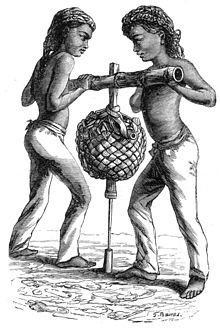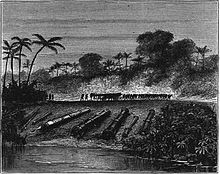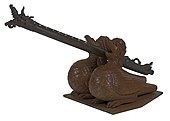
Bedil is a term from Maritime Southeast Asia which refers to various types of firearms and gunpowder weapons, from small pistols to large siege guns. The term bedil comes from wedil (or wediyal) and wediluppu (or wediyuppu) in the Tamil language. In their original form, these words refer to gunpowder blast and saltpeter, respectively. But after being absorbed into bedil in the Malay language, and in a number of other cultures in the archipelago, Tamil vocabulary is used to refer to all types of weapons that use gunpowder. The terms bedil and bedhil are known in Javanese and Balinese. In Sundanese the term is bedil, in Batak it is known as bodil, in Makasarese baddilik, in Buginese, balili, in Dayak language, badil, in Tagalog, baril, in Bisayan, bádil, in Bikol languages, badil, and in Malay it is badel or bedil.
History
It is possible that gunpowder weapons were used in Java by Kublai Khan's Chinese forces who sought to invade Java in 1293. The Javanese gun used in the Majapahit era has also been referred to as bedil.

The knowledge of making "true" firearms probably came to Southeast Asia in the late fifteenth century via the Islamic nations of West Asia, most probably the Arabs. The precise year of introduction is unknown, but it may be safely concluded to be no earlier than 1460. This resulted in the development of Java arquebus, which was also called a bedil. Portuguese influence on Malay weaponry after the capture of Malacca (1511), resulted in a new type of hybrid tradition matchlock firearm, the istinggar.

Portuguese and Spanish invaders were unpleasantly surprised and even outgunned occasionally. Duarte Barbosa recorded the abundance of gunpowder-based weapons in Java c. 1514. The Javanese were deemed as expert gun casters and good artillerymen. The weapon found there include one-pounder cannons, long muskets, spingarde (arquebus), schioppi (hand cannon), Greek fire, guns (cannons), and other fire-works. When Malacca fell to the Portuguese in 1511 A.D., breech-loading swivel guns (cetbang) and muzzle-loading swivel guns (lela and rentaka) were found and captured by the Portuguese. In the battle, the Malays were using cannons, matchlock guns, and "firing tubes". By the early 16th century, the Javanese already produced large guns, some of them still survived until the present day and are dubbed as "sacred cannon" or "holy cannon". These cannons varied between 180 and 260-pounders, weighing anywhere between 3–8 tons, length of them between 3–6 m (9.8–19.7 ft).

Saltpeter harvesting was recorded by Dutch and German travelers as being common in even the smallest villages and was collected from the decomposition process of large dung hills specifically piled for the purpose. The Dutch punishment for possession of non-permitted gunpowder appears to have been amputation. Ownership and manufacture of gunpowder was later prohibited by the colonial Dutch occupiers. According to colonel McKenzie quoted in Sir Thomas Stamford Raffles', The History of Java (1817), the purest sulfur was supplied from a crater from a mountain near the straits of Bali.
For firearms using flintlock mechanism, the inhabitants of the Nusantara archipelago are reliant on European powers, as no Nusantaran smith could produce such complex components. These flintlock firearms are completely different weapons and were known by another name, senapan or senapang, from the Dutch word snappaan. The gun-making areas of Nusantara could make these senapan, the barrel and the wooden part is made in Nusantara, but the mechanism is imported from the European traders.
List of weapon classified as bedil

Below are weapons historically may be referred to as bedil. The full description should be found on their respective pages. It is sorted alphabetically.
Bedil tombak
Locally-made pole gun-type hand cannon.
Cetbang
Refer to 2 type of gunpowder weapon used by Majapahit.
Ekor lotong
Swivel gun with tiller resembling lutung monkey's tail.
Istinggar
A type of matchlock firearm, result of Portuguese influence to Malay weaponry after the capture of Malacca (1511).
Java arquebus
Java arquebus is an early long matchlock firearm from Java, used before the arrival of Iberian explorers.
Lantaka
Lantaka is a type of bronze portable cannon or swivel gun, mounted on merchant vessels and warships in Maritime Southeast Asia.
Lela
Lela is a type of cannon, similar but larger in dimension to rentaka.
Meriam
Formerly used for a kind of cannon that fires a shot weighing 6 pounds or more, now it is de facto Malaysian and Indonesian term for cannon.
Miniature meriam kecil
Also known as currency cannon, this firearm is produced mainly for trading and novelty item.
Pemuras
Native name for blunderbuss.
Rentaka
Native swivel gun, very popular among the Malays.
Terakul
See also
References
- ^ Kern, H. (January 1902). "Oorsprong van het Maleisch Woord Bedil". Bijdragen tot de Taal-, Land- en Volkenkunde. 54: 311–312. doi:10.1163/22134379-90002058.
- Syahri, Aswandi (6 August 2018). "Kitab Ilmu Bedil Melayu". Jantung Melayu. Archived from the original on 15 February 2020. Retrieved 10 February 2020.
- Rahmawati, Siska (2016). "Peristilahan Persenjataan Tradisional Masyarakat Melayu di Kabupaten Sambas". Jurnal Pendidikan Dan Pembelajaran Khatulistiwa. 5.
- Mayers (1876). "Chinese explorations of the Indian Ocean during the fifteenth century". The China Review. IV: p. 178.
- Manguin, Pierre-Yves (1976). "L'Artillerie legere nousantarienne: A propos de six canons conserves dans des collections portugaises" (PDF). Arts Asiatiques. 32: 233–268. doi:10.3406/arasi.1976.1103. S2CID 191565174.
- Pramono, Djoko (2005). Budaya Bahari. Gramedia Pustaka Utama. ISBN 9789792213768.
- "Mengejar Jejak Majapahit di Tanadoang Selayar – Semua Halaman – National Geographic". nationalgeographic.grid.id (in Indonesian). Retrieved 2020-03-19.
- ^ Crawfurd, John (1856). A Descriptive Dictionary of the Indian Islands and Adjacent Countries. Bradbury and Evans.
- Hasbullah, Wan Mohd Dasuki Wan (September 2013). "Teknologi Istinggar Beberapa Ciri Fizikal dalam Aplikasi Teknikalnya". International Journal of the Malay World and Civilisation (IMAN). 1: 51–59.
- Atsushi, Ota (2006). Changes of regime and social dynamics in West Java : society, state, and the outer world of Banten, 1750–1830. Leiden: Brill. ISBN 978-90-04-15091-1.
- Jones, John Winter (1863). The travels of Ludovico di Varthema in Egypt, Syria, Arabia Deserta and Arabia Felix, in Persia, India, and Ethiopia, A.D. 1503 to 1508. Hakluyt Society.
- Stanley, Henry Edward John (1866). A Description of the Coasts of East Africa and Malabar in the Beginning of the Sixteenth Century by Duarte Barbosa. The Hakluyt Society.
- Partington, J. R. (1999). A History of Greek Fire and Gunpowder. JHU Press. p. 224. ISBN 978-0-8018-5954-0.
- Charney, Michael (2004). Southeast Asian Warfare, 1300–1900. Brill. ISBN 9789047406921.
- Gibson-Hill, C. A. (July 1953). "Notes on the old Cannon found in Malaya, and known to be of Dutch origin". Journal of the Malayan Branch of the Royal Asiatic Society. 26: 146–174.
- Modern Asian Studies. Vol. 22, No. 3, Special Issue: Asian Studies in Honour of Professor Charles Boxer (1988), pp. 607–628 (22 pages).
- ^ Raffles, Thomas Stamford (2010) . A History of Java Volume 1 (. ed.). Cambridge: Cambridge University Press. ISBN 978-0-19-580347-1.
- Dipanegara, P.B.R. Carey, Babad Dipanagara: an account of the outbreak of the Java war, 1825–30 : the Surakarta court version of the Babad Dipanagara with translations into English and Indonesian volume 9: Council of the M.B.R.A.S. by Art Printing Works: 1981.
- Raffles, Sir Thomas Stamford (1830). The History of Java, Volume 2. Java: J. Murray.
- ^ Egerton, W. (1880). An Illustrated Handbook of Indian Arms. W.H. Allen.
- ^ Tarling, Nicholas (1999). The Cambridge History of Southeast Asia. Cambridge University Press. ISBN 978-0-521-66370-0.
- Hasbullah, Wan Mohd Dasuki Wan (2014). "Manuskrip Ilmu Bedil Sebagai Sumber Etnosejarah Teknologi Senjata Api Melayu". Jurnal Kemanusiaan. 21: 53–71.
- Teoh, Alex Eng Kean (2005). The Might of the Miniature Cannon A treasure of Borneo and the Malay Archipelago. Asean Heritage.
- Andaya, L. Y. 1999. Interaction with the outside world and adaptation in Southeast Asian society 1500–1800. In The Cambridge history of southeast Asia. ed. Nicholas Tarling. Cambridge: Cambridge University Press, 345–401.
- Filipino Blade Culture and the Advent of Firearms
- Gardner, G. B. (1936). Keris and Other Malay Weapons. Singapore: Progressive Publishing Company. p. 93.
- Dewan Bahasa dan Pustaka (2014). Kamus Dewan Edisi Keempat. Dewan Bahasa dan Pustaka.
- Departemen Pendidikan Nasional (2008). Kamus Besar Bahasa Indonesia Pusat Bahasa Edisi Keempat. Jakarta: PT Gramedia Pustaka Utama.
| Indonesian traditional weapons, armors, and premodern gunpowder-based weapons | ||||||||||||||||||||
|---|---|---|---|---|---|---|---|---|---|---|---|---|---|---|---|---|---|---|---|---|
|    | |||||||||||||||||||
| ||||||||||||||||||||
| ||||||||||||||||||||
| ||||||||||||||||||||
